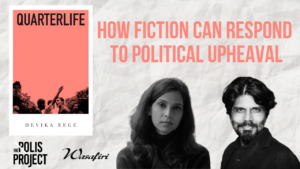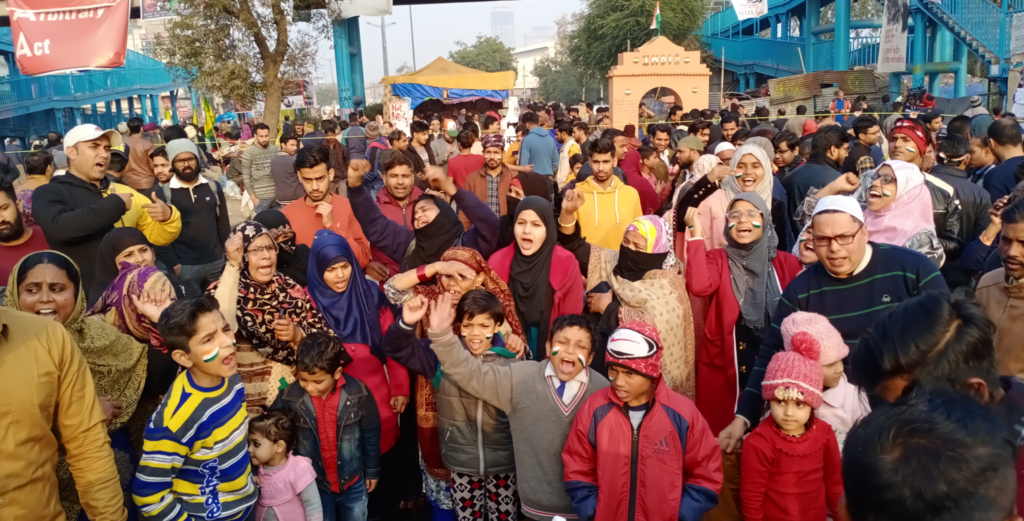
In India, the otherization of Muslims mines citizenship at the foundations: of exclusion, excesses and abdication

In December 2019, the Indian government passed a law that effectively seeks to render Indian Muslims stateless. The systematic exclusion of Muslims through such legislation cannot be seen in isolation but is the result of the protracted combination of deliberate executive actions with the silence of the Courts.

“Constitution is not a mere lawyers document, it is a vehicle of life, and its spirit is always the spirit of Age.” – Bhimrao Ramji Ambedkar
The Citizenship (Amendment) Act (CAA) was passed on 12 December 2019 and came into force on 10 January 2020. The Act grants Indian citizenship to people of all religions (except Muslims), who have allegedly faced religious persecution in their home countries, namely Pakistan, Bangladesh and Afghanistan. The Indian government claims that this is a humanitarian legislation intended to benefit minorities coming from these Muslim countries. However, when combined with the National Population Register (NPR) and the National Register of Citizens (NRC), this law threatens the citizenship status of millions of Muslims in India. The United Nations Human Rights Office (UN OHCHR) and several international bodies have also stated that the CAA is fundamentally discriminatory in nature.
In India, the judiciary has the powers of judicial review under the Constitution,[1] which confers a duty upon the Courts to interpret laws and check executive actions that are violative of fundamental rights. The passing of the CAA by the Parliament, and the preceding and consequent actions of the ruling Bharatiya Janata Party (BJP) government, cannot be observed in isolation. In recent times, executive action (which also includes inaction) and exclusionary legislations have gone largely unchecked by the judiciary. Cumulatively, this has ensured a targeted social reorganizing on the ground to propagate anti-Muslim rhetoric while granting complete impunity to the active participants.
Since 2014, the otherizing of the Muslim body has been carried out to a large extent under the name of cow protection. In 2015, Mohammed Akhlaq, a 52-year-old Muslim laborer, was lynched by a mob inside his house for allegedly slaughtering a cow in Dadri, Uttar Pradesh (UP). The seventeen men accused of his lynching are out on bail and some of them have even contested elections. In 2017, in an attack that was carried out in a similar manner, Pehlu Khan and his sons were attacked in Alwar, Rajasthan, on suspicion of smuggling cows. Even in this case, the six men accused of his lynching, which was recorded on camera, were acquitted by a court in Rajasthan. An extensive study carried out by IndiaSpend shows that 84% of the individuals who have died in cow-related violence are Muslims, and that these attacks, which the study refers to as “cow terrorism,” were higher in number in BJP ruled states. The study has also noted that 97% of these attacks were carried out after 2014.
During its second term, the strategy of the government under the tenure of Prime Minister Narendra Modi has focused on sanctioning exclusion and criminalization of the Muslim community through the law. In 2019, Muslim Women (Protection of Rights in Marriage) Act was passed by the Parliament: it criminalizes the Triple Talaq and makes it a cognizable and non bailable offence with up to three years of imprisonment. The Bill was opposed by Muslim women, activists and family law practitioners. Despite that, the Bill was passed with an inexplicable urgency and became the top priority of the government, which sought to supposedly save Muslim women. Muslim women activists, however, opposed the Bill and stated that it further victimizes Muslim women and that criminalizing the Triple Talaq would lead to fear and cause strife in the community. The Bill also did not consider that if the husband is jailed, the woman will face ostracization and isolation without financial support or social security. In the election campaign in several states, the BJP has used this bill as an advertising strategy to promote themselves as saviors of Muslim women and promoters of gender equality. The Bill, which has now become a law, however, has become a tool to incarcerate Muslim men, who are already disproportionately represented in Indian prisons. According to a 2016 report, Muslims constitute 21.05% of the under trial population in Indian prisons.
In August 2019, the Unlawful Activities (Prevention) Amendment Act (UAPA) was passed by the Parliament. The amendment, amongst other provisions, gives powers to the Central Government to declare individuals as terrorists. There is clear record that in the past counter-terror legislations like the UAPA (which provides for up to six months of pre-trial detention and makes obtaining bail almost impossible) have been used to target minorities.
In November 2019, the Supreme Court gave its verdict in a decades-old pending dispute concerning a disputed site where a mosque, the Babri Masjid, was situated until 1992 when it was demolished by a Hindu mob constituted of members of a youth wing of the BJP. Many Hindus maintain that the site was the birthplace of Lord Ram. In its order, the Court granted 2.77 acres of land to the Hindu parties for the construction of a temple despite holding the demolition of the mosque as a criminal act. This relief allowing the construction of a temple in the disputed site seems to be a virtual mandamus to demolish the mosque.
Soon after this judgment, the CAA was introduced in the Parliament. After the Bill was passed, it generated widespread protests led primarily by women. The protests were met with unprecedented open attacks on protestors and minority institutions. In order to curb the protests, in fact, BJP-ruled states imposed Section 144 Cr.P.C. This consequently came to be weaponized by state agencies to unleash an unchecked and excessive amount of force on university students and protestors alike. The gravity of the excessive use of force was observed by the Allahabad High Court, which subsequently granted compensation to students who were grievously injured, along with directing sensitization and special training of police officials.
These women inspired several similar protests across the country: around five of these ‘Shaheen Baghs’ were in Delhi itself. New Delhi became one of the main centers of protests against the CAA. One of the most iconic manifestation was at Shaheen Bagh with a continuous sit in led by Muslim women close to Jamia University. These women inspired several similar protests across the country: around five of these ‘Shaheen Baghs’ were in Delhi itself. It was in one of these protest sites, at Maujpur Chowk, that in the last week of February violence unfolded after BJP leader Kapil Misra issued an open threat to spontaneously vacate the protest sites – failing which, he said, he would ensure it would be done any way. No First Information Report (FIR) has been registered against him to date, and petitions seeking the same remain pending in Court. On the other hand, several community leaders including Khalid Saifi and Ishrat Jahan have been arrested. In the month of April 2020, UAPA was invoked against several Muslims, including students who led the protests against the amended citizenship law. One of the arrested students, Safoora Zargar, is in the second trimester of her pregnancy. This has been done at a time when the whole country has been under a lockdown due to COVID-19 and the central government itself has passed guidelines for strict observance of social distancing, including decongestion of the overcrowded prisons in India. This situation has also made access to legal aid and necessary support difficult for those arrested.
The pattern of execution of violence in North East Delhi is very similar to the violence observed in 2002 in Gujarat, when Modi was the then Chief Minister of Gujarat. In 2002, the homes, businesses and properties of Muslims were attacked by Hindu mobs leaving around 790 Muslims dead, including Member of Parliament Ehsan Jafri. The Special Investigation Team, constituted by the Supreme Court to investigate the 2002 violence in Gujarat, filed its closure report in 2012, stating that no evidence was found regarding the involvement of Narendra Modi and other senior officers in the Gujarat pogrom.
In 2020, in the run up to Delhi elections, BJP led a polarizing and hateful campaign, which continuously addressed the Shaheen Bagh protestors as terrorists, and openly targeted the Muslim community. This, along with BJP losing elections in Delhi, escalated into a full-blown pogrom. Even though years apart, in both of these situations, the attack on Muslims with complete impunity to the perpetrators highlights the distressing pattern of vilification of the Muslim community in Modi’s regime.
Another targeted attack on the Muslim community and anti-CAA protestors was carried out by the Uttar Pradesh Police in December 2019. As the protests against CAA broke out across UP, Chief Minister Yogi Adityanath stated that his government will take “revenge” on those involved in the violent protests by auctioning their property to compensate for the losses allegedly incurred due to damage of public property. Moreover, during these protests, 23 Muslim laborers were killed by the Police, 41 minors were illegally detained and tortured, and several hundred people were arrested. Also, posters of ‘most-wanted’ individuals who allegedly participated in the protests cropped up in some parts of Uttar Pradesh. A banner was displayed on a major crossing in Lucknow with photos and personal details of more than 50 people accused of vandalism during the December 2019 protests. The banner sought compensation from the accused protestors and in case of failure to do so, it sought confiscation of their property. This exercise amounted to a virtual declaration of criminality prior to a trial. The Allahabad High Court, in an unprecedented move, on a Sunday morning, took suo motu cognizance of the legitimacy of such display of photographs, name and address of these individuals by the district and police administration. In a 14-page judgment, the Court directed the concerned authorities to take down the banners. By doing this, the Allahabad High Court displayed what the Courts are capable of doing in matters concerning the violation of fundamental rights. In response to the executive’s objection to the power of the Court to entertain a public interest litigation on its own motion, the Court, while highlighting the importance of checks and balances in the functioning of the three wings of governance, observed that:
“where there is gross negligence on part of public authorities and government, where the law is disobeyed and the public is put to suffering and where the precious values of the constitution are subjected to injuries, a constitutional court can very well take notice of that at its own. The Court in such matters is not required to wait necessarily for a person to come before it to ring the bell of justice. The Courts are meant to impart justice and no court can shut its eyes if a public unjust is happening just before it.” [PIL No. 532 of 2020, pp. 4 – 5]
The Court further observed that the executive’s actions seems to be a “colorable” exercise of its powers insofar as the personal data of a few persons had been exposed, while there were thousands of accused in the State who were facing serious allegations of crimes, but whose personal details had not been subjected to publicity.
While these observations are not new, it is the backdrop of this judgment that is of relevance. This order came at a time when several petitions pertaining to individual life and liberty in light of other colorable executive actions remain pending before the Supreme Court. In the past few months, the Supreme Court has shown restraint in entertaining petitions pertaining to police excesses in curbing dissent. When a court-monitored probe was sought into the reports of police atrocities against the students of Jamia Milia Islamia and Aligarh Muslim University, the Supreme Court asked the petitioners to approach the concerned High Courts.
While the High Courts in recent times have been relatively proactive in matters concerning life and personal liberty and in questioning the executive, what can be observed in the recent Supreme Court orders is a retreat backwards from the 1978 interpretation of the constitutional provision guaranteeing the right to life and personal liberty (Article 21). In 1978, the Supreme Court by reading the clause of due process into Article 21, created the groundwork for expansion of the scope of Article 21. This, amongst other things, led to many reforms in the criminal justice administration in the country.
Recently, the Chief Justice of India remarked that there are limitations on the Court’s powers and that it cannot give preventive reliefs. This observation came when an urgent mention was made for hearing a plea on filing FIRs against the BJP politicians who made hate speeches preceding the targeted violence in North East Delhi. It is in this light that the suo motu cognizance taken by the High Court of Allahabad and its subsequent decision in the banners case assumes much significance. As a protector and guardian of the Constitution, a duty is cast upon the Courts to safeguard these values and catalyze the process of justice delivery.
What unfolded in Delhi in the last week of February is part of a larger systematic process followed by the State to exclude Muslims, and the subsequent use of excesses to curb any form of dissent or dialogue put citizens in a rather precarious situation. The anti-Muslim sentiment has not only been institutionalized through exclusionary laws and policies but also seeped into the larger public conscience. The anti-CAA movement strikes at the very root of this sentiment.
The protests against the amended citizenship law at all points refer to protecting the Constitution. The reclamation and development of a shared understanding of the Constitution by collective reading and interpretation has been unparalleled in contemporary history. The Indian Constitution is a document that informs all the institutions of governance. It also confers wide powers upon the higher judiciary to ensure that the executive and legislature do not transgress constitutional limitations in exercise of their powers. While a counter-argument on separation of powers is cited in this regard, it is important to remember that the doctrine cannot have a strict application in any modern government. The Allahabad High Court judgment in the banners case is effectively saying this: as an institution of trust, public faith and confidence, the Court must not look away in the face of a deliberate public wrong. However, what remains to be seen is how this institution will interpret the voices of the people, echoed in the hundred-plus petitions pending before it.
In the light of Covid-19 lockdown in India, national media houses and some political leaders have been actively involved in vilification of Muslims and labelling them as the carriers of coronavirus. Over the last few years, fueling Islamophobia in people’s minds has resulted in an otherization that is such that even in a pandemic Muslims in India have been villainized and discriminated against. This discrimination includes the denial of health services and an economic boycott in several places.
The Muslim community in India is gripped with dismay and fear, and the indifference by state agencies toward this violence remains deeply disconcerting. Yet, concerned citizens and activists are finding new ways to resist and fight back.
[1] By virtue of Articles 13, 32, 131-136, 143, 226 and 246 of the Indian Constitution





